 |
Inside the church of Sant'Agnese. The gallery over the aisles was originally at ground level; the floor of the church was sunk into the catacombs in which Saint Agnes was buried. |
"The central aisle or 'road forward' is a symbol of the length of life: the life of all creation, of all humanity, of the Church as a community, of each individual person." (p.57)
|
|
|
|
 |
|
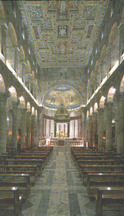 |
"The people in a church are on a journey, the 'journey of life,' towards their destiny, which is God. Time—the life of the group, the lifetime of each individual person—is expressed as space. Moving up the nave and aisles is moving towards our end: our aim ('end' as purpose) and also our body's death. Movement and immobility, the temporal and the eternal, time and space: all these oppositions are expressed in a church's geometry." (p.32)
|
| The life-sized bronze crucifix in the left aisle. The feet have been rubbed golden with kissing. On the wall on the left is one of the church's dedication crosses. (pp.83, 150, 127) |
|
The nave leading to the apse. |
|
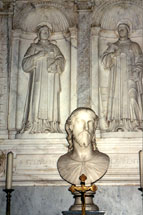 |
 |
|
"By the late nineteenth century it was thought preferable to hang a painting of the Madonna of Pompeii on top of the original fresco and inside its ornmental frame, either because the new image had a greater popular appeal, or because the picture of Mary openly breastfeeding may now have seemed less than suitable in a church, or both...The fifteenth-century fresco once again has pride of place." (pp.143-144) |
|
| The virgin mother, symbol of the Church. |
|
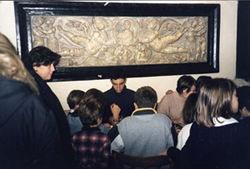 |
|
The Altar of the Saviour. The bust of Christ is by Nicolas Cordier, and the reredos with SS. Stephen nd Lawrence by the studio of Andrea Bregno. The altar front, found face down in the canonry's kitchen, was once part of the medieval main altar ensemble. (pp.154-158) |
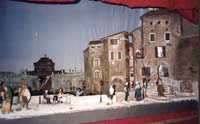 |
|
Parish members making Christmas crib settings. Behind them, a second-century Roman sarcophagus, found in the grounds of Sant'Agnese's. It was once thought to be the tomb of Saint Agnes. (p.165) |
|
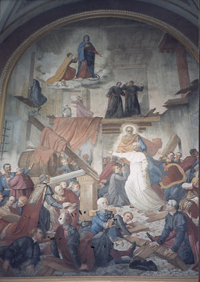 |
| Part of a crib scene, from the chapel of Saint Emerentiana at Christmas time. (pp.163-164) |
|
"Nothing in the church or the surroundings of Sant'Agnese's is likely to seem as strange today as do these neneteenth-century images of hearts...But even someone repelled by the "heart" pictures can see that they are far more deeply felt than the older paintings. I believe it is the sentiment itself that many people today would find most distasteful." (p.145) |
|
|
|
|
Pope falls in: painting by Domenico Toretti, to commemorate the accident in the canonry, April 12, 1855. (pp.164-166) |
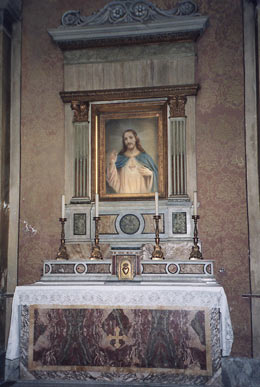 |
|
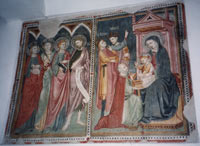 |
|
 |
| The altar of the Sacred Heart chapel. (pp.145-151) |
|
Fourteenth century fresco, one of several on the walls of the canonry. The four saints on the left are John the Baptist, John the Evangelist, Emerentiana, and Agnes. They reflect four of the altars once in the church. The three kings bring presents to the Virgin and Child on the right. (pp.161-162) |
|
In the Sacristy in Sant'Agnese's is this painting of Agnes surrounded by other female martyrs, each one carrying her attribute. |
|
|
|
|
|






















